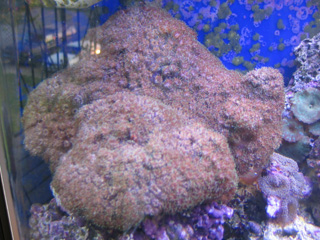|
FAQs about Oculinid/Galaxy Coral
Reproduction/Propagation
Related Articles: Oculinids, Galaxy Corals,
Related FAQs: Oculinids 1, Oculinids 2, & FAQs on: Oculinid Identification, Oculinid Behavior, Oculinid Compatibility, Oculinid Selection, Oculinid Systems, Oculinid Feeding, Oculinid Health, & Stony/True Coral, Coral System Set-Up, Coral System Lighting, Stony Coral Identification, Stony Coral Selection, Coral Placement, Foods/Feeding/Nutrition, Disease/Health, Propagation, Growing Reef Corals, Stony Coral Behavior,
|

|
Galaxea sp. Coral Anybody ever been successful
fragging these corals. I have one that is fast approaching the size of
a soccer ball in my 92 gal office tank and I would like to frag it. I
know quite a few years back Albert did a demonstration fragging certain
LPS and I think it involved a Dremel. Any thoughts or suggestions?
Anybody near Madison, WI want to help? -Howard >> Oculinids
(family containing genus Galaxea) can/are divided with hand tools...
for asexual, commercial "fragging"... We use a lowered spg.
iodine and hexose sugar dip immediately afterward... Dick
Perrin's/Tropicorium got the biggest run of these going... about
four species, one, two year classes. Bob Fenner, in sunny southern
cal.
| Galaxea Coral Hi <Hi Gaurav> I have a question
regarding a tooth coral, Galaxea coral. I have one that is more
than 12 inches in diameter. it is getting too big for my aquarium
so I am thinking about fragging it. but I have never fragged a LPS
hard coral before so I need some suggestions on how to do it. <I
think fragging your coral is a wonderful idea. I'd like to
suggest you use Anthony Calfo's "Book of Coral
Propagation" as a reference and there are some wonderful
websites that deal specifically with coral
fragmentation. WWW.fragexchange.com is one that
immediately comes to mind> or do you have any better idea of
what I should do about it. I have included a few pictures of it for
reference. thanks for any suggestions you can give me. <If I may
quote Anthony, "Galaxeas are fused colonies of individual,
tubular corallites. Each cylinder crowned with a polyp can
theoretically live on its own when separated. Coral farmers take
colonies of Galaxea and rip paths between the corallites with an
electric saw. Wire saw blades work well for this approach.. . .
Propagated divisions laid on their side or against hard surfaces
will quickly encrust and continue to grow.> <I
also know people who use a Dremel and do it on a lesser level. Good
luck, Gaurav, I do encourage you to document what you do and post
it on one of the websites. MacL> Gaurav |
|

|
|
|

